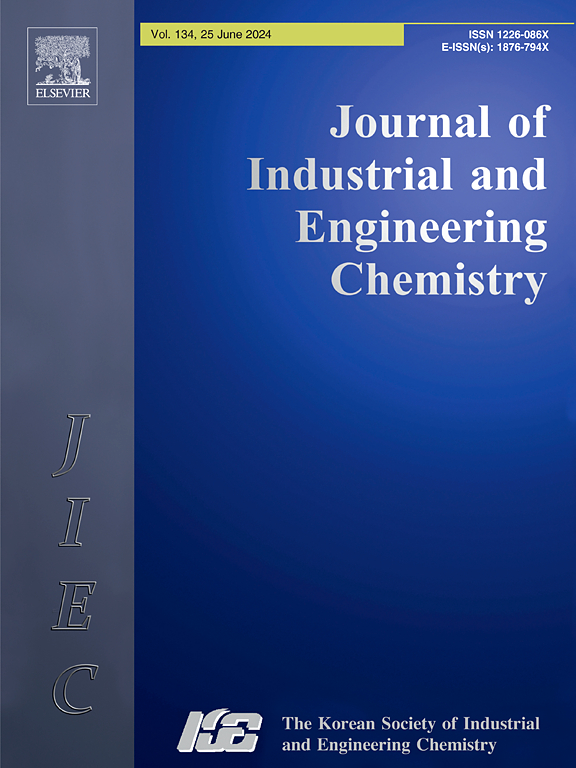利用深共晶溶剂分离氢氟碳化合物可持续途径的热物理表征
IF 5.9
3区 工程技术
Q1 CHEMISTRY, MULTIDISCIPLINARY
Journal of Industrial and Engineering Chemistry
Pub Date : 2024-12-05
DOI:10.1016/j.jiec.2024.12.005
引用次数: 0
摘要
氢氟碳化合物(HFCs)在制冷领域的广泛使用带来了重大的环境挑战,因为它们具有很高的全球变暖潜力。有效的回收和分离技术是减轻其不利影响和促进可持续性的必要条件。本研究利用氯化胆碱([Ch]Cl)和四甲基氯化铵(TMAC)为基础的深共晶溶剂(DESs)作为环保、低毒和低成本的替代品,研究了四种常见的氢氟碳化物(R-125、R-134a、R-32和R143a)的溶解度行为,其中一些溶剂在分离氢氟碳化物混合物中表现出良好的选择性。新的实验数据通过采用软saft方程进行全面的热力学表征来完成。该模型能够描述纯DESs的密度和粘度,溶解焓和熵,亨利常数和理想选择性。根据这些结果,预测了多组分共混体系和DESs中气体之间的竞争选择性。对DESs的亲和力最高的是R-32,其次是R-134a、R-143a和R-125,而TMAC:EG(1:3)对所有hfc的吸收能力最高。尽管吸收率相对较低,但含有TMAC:GL(1:3)和[Ch]Cl:GL (1:3) + 10 wt%的DESs在分离氢氟碳化物混合物,特别是含有R-32的氢氟碳化物混合物方面表现出很好的选择性,这对回收R410A和R407F等商业共混物具有重要意义。本文章由计算机程序翻译,如有差异,请以英文原文为准。

Thermophysical Characterization of Sustainable Pathways for Hydrofluorocarbons Separation Utilizing Deep Eutectic Solvents
The widespread use of hydrofluorocarbons (HFCs) in refrigeration ushered in a significant environmental challenge due to their high global warming potential. Effective recovery and separation techniques are imperative to mitigate their adverse impacts and promote sustainability. This study investigates the solubility behavior of four common HFCs (R-125, R-134a, R-32, and R143a) using choline chloride ([Ch]Cl) and tetramethylammonium chloride (TMAC) based Deep Eutectic Solvents (DESs) as ecofriendly, low-toxicity and low-cost alternatives, provided the promising selectivity exhibited by some of them in separating HFC mixtures. The new experimental data are completed by a comprehensive thermodynamic characterization employing the soft-SAFT equation. This modeling enables the description of the density and viscosity of pure DESs, enthalpy and entropy of dissolution, Henry’s constants, and ideal selectivity. From these results, the competitive selectivity among gases in multi-component blends and DESs is predicted. R-32 appears to have the highest affinity in DESs, followed by R-134a, R-143a, and R-125, while TMAC:EG (1:3) shows the highest absorption capacity for all HFCs. Despite relatively low absorption rates, DESs containing TMAC:GL (1:3) and [Ch]Cl:GL (1:3) + 10 wt% exhibit promising selectivity for separating HFCs mixtures, especially those containing R-32, which holds significance for applications in recovering commercial blends like R410A and R407F.
求助全文
通过发布文献求助,成功后即可免费获取论文全文。
去求助
来源期刊
CiteScore
10.40
自引率
6.60%
发文量
639
审稿时长
29 days
期刊介绍:
Journal of Industrial and Engineering Chemistry is published monthly in English by the Korean Society of Industrial and Engineering Chemistry. JIEC brings together multidisciplinary interests in one journal and is to disseminate information on all aspects of research and development in industrial and engineering chemistry. Contributions in the form of research articles, short communications, notes and reviews are considered for publication. The editors welcome original contributions that have not been and are not to be published elsewhere. Instruction to authors and a manuscript submissions form are printed at the end of each issue. Bulk reprints of individual articles can be ordered. This publication is partially supported by Korea Research Foundation and the Korean Federation of Science and Technology Societies.

 求助内容:
求助内容: 应助结果提醒方式:
应助结果提醒方式:


